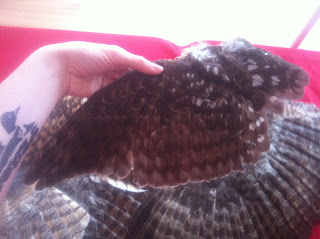Stewards
This small program has the potential to open a lot of doors for youth who would like to work within the conservation sciences. Bird Studies Canada is one of the most important organizations for developing and implementing conservation strategies for Canada's avian biodiversity. Even this action has a ripple effect, as whole ecosystem protection helps those who are passionate about plant, reptile and amphibian, butterfly and ALL types of animal conservation.
For those who are interested, Bird Studies Canada's website can be reached
here. They also host a fabulous workshop, the Doug Tarry Young Ornithologists' Workshop, where I would encourage bird crazy students to apply. More information can be found on
this link.
Outdoor Education
One of the most encouraging experience I had from this project was how much enthusiasm there was from everyone, young and old, to go out and see these colourful birds that they had only just then learned about.
I made many suggestions for where families could go to observe these birds, both near and far.
I especially emphasized High Park and that they have extensive information about the birds of the park, which can be accessed
here.
As well, for those who are more knowledgable about birds, they can target rare or hard to find birds using the Ontario Ornithological Organization's
Rare Bird Alert website. It also highlights migration trends and good spots to see birds in high numbers.
The Leslie Street Spit is also an amazing place where people can go to view birds in abundance. It also is host to the
Tommy Thompson Bird Research Station where I have banded. There is a large public outreach program involved which allows for up close and personal experiences with birds in the hand, and an opportunity to learn about the science behind banding and the type of information that is collected. The regularly post photos and updates about the diversity and numbers of birds banded each day during migration on their
Facebook page found here.
Propel the Knowledge of Science Further
During the many hundreds of discussions I had each day, many of them focused on the science behind the words I was saying; how do you know its this bird, how do you know where it goes to overwinter, how do you know it is endangered, how can we conserve them? All these questions are answered through the work of dedicated scientists.
I recommended that very keen bird watchers should check out Cornell University's online ornithological data base named
Ebird. It links observations from around the world into one very user friendly website.
Getting youth involved in any of the number of organizations I have listed is a great way to start on a journey that may lead to academically studying birds and their conservation.
Make Someone THAT Much More Empathetic to Nature
I'd like to share some of the photos I have that prove that a little bit of bird love goes a long way!
I had a fondness for birds from a very young age!
I've inspired my friends a lot! Including this jeweller's creations.
Here I am showing the wonders of a Saw-whet Owl to the public!
I've worked for many different organizations, including this one in Texas where I would show the public different pest management techniques (Brown-headed Cowbirds).
I get my friends HOOKED on birds too! My friend Francois has travelled with me to many places in search of birds and mollusks (his primary interest).
Just one experience with a bird can be life changing! Had such a connection with this Wandering Albatross, as many people do in New Zealand.
The Wandering Albatross and all seabirds are facing huge perils because of the fishing industry and oceanic pollution. Since there is this empathy that exists between Kiwis and seabirds, public outreach is ever present and and most of the citizens are advocates for conservation change! Amazing!
Another friend who shares immense bird love! The more you go out, the more you create a network of friends who also love nature as much as you do. These connections can create a powerful voice of people who are committed to conservation of ALL species!
Even if it is just a more compassionate heart for creatures in our backyard, like this Mourning Dove, we can create urban safe centres for wildlife.
While this was just a small public outreach event, I think it increases the general knowledge of everyone about threats to biodiversity and also exposure to all the different creatures that SHARE the land with us. While not everyone will be interested, the few who share the same level of passion for birds and avian conservation now know of a few more avenues where they can turn to for guidance.





























